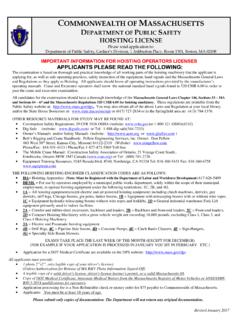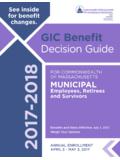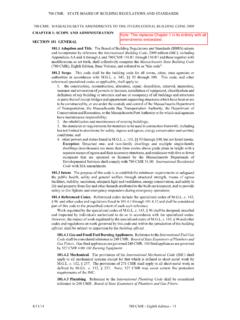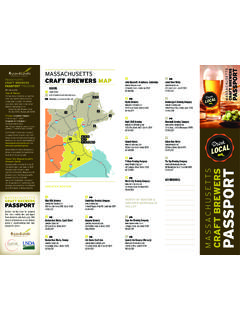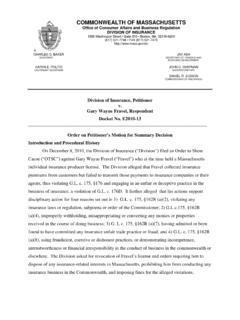Transcription of In-Home Behavioral Services (IHBS) Practice Guidelines
1 In-Home Behavioral Services (IHBS). Practice Guidelines CBHI-IHBS-PG (12/15). In-Home Behavioral Services Practice Guidelines Table of Contents Purpose of the In-Home Behavioral Services Practice 5. The Children's Behavioral Health Initiative (CBHI) .. 5. 5. Values (System of Care Philosophy) .. 5. Vision .. 6. Strategic Priorities .. 6. Overview of In-Home Behavioral Services .. 7. Eligibility .. 7. Components of Service Delivery .. 8. Clinical Vignette: Sophie .. 9. What IHBS Is .. 11. What IHBS Is Not .. 11. The IHBS Process.
2 11. Referral .. 12. Hub Waivers .. 13. Initial IHBS Contact with Family .. 13. Assessment .. 14. Getting the Hub's Comprehensive Assessment .. 14. Assessment and the CANS .. 15. The IHBS Functional Behavioral Assessment .. 16. Gathering Data .. 17. Development of the Behavior Support 18. Collaboration with Hub Provider/Care-Planning Team .. 19. Family Voice and Choice in 20. Using Data to Evaluate and Improve Service Effectiveness .. 21. Safety 22. Ongoing Cycle of Implementation and Collaboration .. 22. Clinical Vignette: Jos.
3 24. Preparation and Transition Out of IHBS .. 25. CBHI In-Home Behavioral Services Practice Guidelines 1. Indications for Ending 25. Transition Meeting and Plan .. 26. Early Termination .. 26. Clinical Vignette: Carlos .. 27. Documenting Progress .. 27. Working with Hubs and Other Services .. 28. Youth Engaged in ICC .. 29. Youth Engaged in IHT or Outpatient Therapy .. 30. Therapeutic Training and Support vs. Behavioral Support Monitoring .. 31. Youth Involved with State Agencies .. 31. When the Hub Service Ends .. 32.
4 Augmenting the FBA to Serve as a Comprehensive Assessment .. 32. Providing IHBS to Siblings .. 32. Culturally Relevant Practice .. 33. Staffing, Training, and Supervision Requirements .. 35. Supervision Requirements .. 35. Staff Training .. 35. Credentialing 35. Credentialing Waiver 35. Use of Interns .. 36. Staff 36. Medical Necessity Criteria for Admission .. 37. Access to Care .. 37. Timeframes and Documentation .. 37. Waitlist Activities .. 38. Reporting and Monitoring Access via MABHA ccess .. 39. Access for Non-English-Speaking 40.
5 Billing .. 41. MCE Authorization Parameters and Billing Codes .. 42. Appendix A: Availability of CBHI Services to Members in Various Benefit Plans .. 43. Appendix B: Incorporating Positive Behavior Supports in IHBS .. 44. Appendix C: IHBS Service 44. Appendix D: IHBS Performance Specifications .. 44. CBHI In-Home Behavioral Services Practice Guidelines 2. Appendix E: IHBS Medical Necessity 44. Appendix F: MCE CBHI Health Record Documentation Standards .. 44. Appendix G: CBHI Clinical Pathways Grid .. 45. Appendix H: Tip Sheet for Outpatient Clinicians: Roles and Responsibilities as a CBHI Hub Provider.
6 45. Appendix I: Crisis-Planning Tools .. 45. Appendix J: MCE CBHI Waiver Request Form .. 45. Appendix K: Guidelines for Ensuring Timely Access to CBHI Services .. 46. Appendix L: Access to Care Protocol .. 46. Appendix M: CBHI Referral Log Waitlist v4 .. 46. Appendix N: MCE Common IHBS Clinical Review Questions .. 46. Appendix O: MCE IHBS Initial and Subsequent Authorization Processes .. 46. Appendix P: Crisis-Planning Tools for Families: A Companion Guide for Providers .. 46. Appendix Q: Safety Plan Form .. 46. Appendix R: List of Approved Degrees.
7 46. Appendix S: Definition of Terms .. 47. Acknowledgments .. 52. CBHI In-Home Behavioral Services Practice Guidelines 3. CBHI In-Home Behavioral Services Practice Guidelines 4. Purpose of In-Home Behavioral Services Practice Guidelines These Guidelines outline best practices for the provision of In-Home Behavioral Services (IHBS), which all IHBS providers should strive to implement. The Guidelines describe what IHBS should look like in Practice : They are intended to provide guidance for IHBS. providers and providers of other Behavioral health Services and for families.
8 The Guidelines describe how IHBS works according to youth- and family-centered practices, beliefs, and quality Services consistent with the CBHI mission, values, vision, and strategic priorities. The Guidelines describe how Services should be delivered in order to be most effective. In addition, IHBS is governed by documents that govern what IHBS must do: performance specifications, medical necessity criteria, and provider contracts with MassHealth's Managed-Care Entities (MCE). Many documents referenced throughout the manual are found in the Appendices of this manual and are available as a resource to providers in the CBHI section of the Massachusetts Behavioral Health Partnership (MBHP) website at Additional CBHI resources such as links to training materials can also be found in the Appendices.
9 IHBS is part of an array of MassHealth Behavioral health Services , which include CBHI. home- and community-based Services . A brief description of CBHI Services can be found in Appendix A. The Children's Behavioral Health Initiative (CBHI). Mission CBHI is an interagency initiative of the Commonwealth of Massachusetts Executive Office of Health and Human Services , whose mission is to strengthen, expand, and integrate state Services into a comprehensive, evidenced-based, community-based system of care to ensure that families and children with significant Behavioral , emotional, and mental health needs obtain the Services necessary for success in home, school, community, and throughout life.
10 Values (System of Care Philosophy). Child-Centered and Family-Driven: Services are driven by the needs and preferences of the child and family, developed in partnership with families, and accountable to families. Strengths-Based: Services are built on the strengths of the family and their community. CBHI In-Home Behavioral Services Practice Guidelines 5. Culturally Responsive: Services are responsive to the family's values, beliefs, and norms, and to the socioeconomic and cultural context. Collaborative and Integrated: Services are integrated across child-serving agencies and programs.
